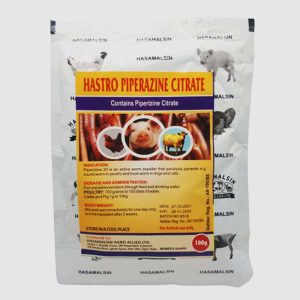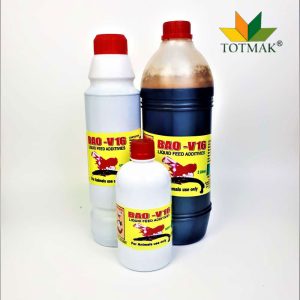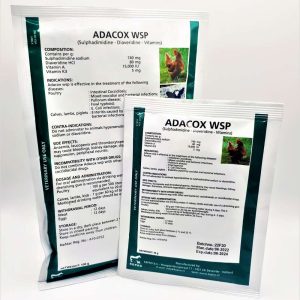TRISULPHANOR 100g
₦7,300.00
TRISULPHANOR® is highly effective against most of the Eimeria species that cause coccidiosis in both caeca and intestine of poultry and other animals. Also active against gram-negative and gran-positive bacilli infections such as streptococcus pyogenes, salmonella, pneumobacillus, fowl cholera, fowl typhoid, etc., and can also be used for Toxoplasma infection.
INDICATIONS
TRISULPHANOR® is highly effective against most of the Eimeria species that cause coccidiosis in both caeca and intestine of poultry and other animals. Also active against gram-negative and gran-positive bacilli infections such as streptococcus pyogenes, salmonella, pneumobacillus, fowl cholera, fowl typhoid, etc., and can also be used for Toxoplasma infection.
ADMINISTRATION AND DOSAGE
Chicken: 1g per 2 litres of drinking water for 3 successive days. After 2 days of interruption, the treatment may be continued for another 3 days. Alternatively, 50mg-100mg of TRISULPHANOR® per 1kg body weight into the drinking water daily.
CONTRAINDICATION
In case of renal dysfunction, slow excretion should be used with caution. It can cause intestinal flora imbalance, long-term medication can cause the reduction of vitamin B and vitamin K synthesis and absorption. Overdose may cause restlessness and convulsion, as a result, the recommended dosage must be adhered to avoid these side effects.
WITHDRAWAL PERIOD
- Poultry: Chicken: 10 days.
- Eggs: Do not use in layers producing eggs for human consumption.
STORAGE
Store in a tightly sealed container, protected from light, and at room temperature below 30 °C.
ADVERSE REACTION
The sulfamethazine and diaminopyrimidines (TMP) combination, can produce a synergistic effect. Do not combine with Procaine or Tetracaine which can reduce the effect of the drug. Combining with Thiazides or diuretics can increase renal toxicity. Antacids and Sulfonamides combined can reduce its bioavailability. Some p-aminobenzoic-containing drugs such as procaine, tetracaine, and others in vivo can produce PABA, yeast tablets containing bacterial metabolism require PABA, can reduce the drug effect, it should not be combined.
Larger doses of salicylic acid, sulfonamides, and other drugs can affect the effect of vitamin K. Barbiturates can induce accelerated metabolism of vitamin K.
PHARMACOLOGICAL ACTIONS
Sulfamethazine is similar in structure to PABA, compete with bacterial dihydrofolate synthetase in vivo with PABA, hamper dihydrofolate synthesis, and reduce the amount of tetrahydrofolic acid, ultimately affect the synthesis of nucleic acids, inhibit growth and reproduction of bacteria. Sulfamethazine may be antagonized by PABA and its derivatives (procaine and tetracaine). In addition, pus and tissue degradation products can also provide the necessary material for bacterial growth, which may antagonize sulfonamides. The antibacterial effect of this product is relatively weaker than sulfamethazine, but SM2 has a favorable inhibitory effect against coccidiosis and toxoplasmosis.
Chitosan (Vitamin K3) is a necessary material for the synthesis of the prothrombin gene (factor II) in the liver and is involved in the synthesis of coagulation factors VII, IX, and X. Used as Vitamin K supplements.
Vitamin A has the role of promoting growth, maintaining epithelial tissue such as skin, conjunctiva, cornea, and other normal function, and participating in the synthesis of rhodopsin, enhancing retinal sensitivity. In addition, it is also involved in many oxidation processes in the body, especially the oxidation of unsaturated fatty acids. Vitamin A deficiency occurs when the growth stops, bone growth, reproductive capacity decreased, rough skin, dry, corneal softening and dry eye inflammation and night blindness, and so on.
SHELF LIFE: 4 Years
Additional information
| Weight | 0.127 kg |
|---|








